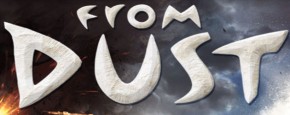From Dust
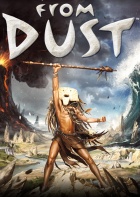

| Game Name: | From Dust |
| Platforms: | Playstation 3, Xbox 360, PC (reviewed) |
| Publisher(s): | Ubisoft |
| Developer(s): | Ubisoft Montpellier |
| Genre(s): | God game |
| Release Date: | July 27, 2011 |
| ESRB Rating: | E10+ |
| Big Ups: | Solid gameplay, varied and beautiful locales, interesting gameplay mechanics |
| Big Downs: | Bugs, poor controls |
When I hear a game attributed to the god game genre, I expect a heavily immersive epic that celebrates the human existence. Currently, developers find it difficult to make games that meet the new and lofty achievements accomplished by ever evolving indie games like Dwarf Fortress. This also makes them hard pressed to introduce creative and new ideas to the genre. From Dust, developed by Ubisoft Montpellier, attempts to introduce new degrees of creativity, but instead, elevates already existing features into the mainstream spotlight. These features are very entertaining but are marred by some poor design choices that heavily limit players from having full and lush experiences.
 Though not having much for story, From Dust creates a world of its own that is both alien and exotic. The player controls “The Breath” which acts as a guide for the minute aboriginal tribes people. The ultimate goal is to use the Breath to strategically guide these tribesman to claim several totems spread throughout each level. This in turn opens a gateway that leads to the next level. However, standing in their path to discovery is the universe’s fiercest adversary, Mother Nature. Each level presents a puzzling combination of environmental effects for the player to solve. These environmental effects include: droughts, torrential rain, flooding, tsunamis, erupting volcanoes, lava flows, and forest fires. Water and lava believably flow through the world creating hair raising situations when trying to protect the defenseless tribesman. To do so, the player uses the Breath to manipulate the environment. It is reminiscent to childhood sandbox days where you would create trenches and build walls in the sand to pour water in them to watch how it flowed over your creation. However, not only can the player pick up sand and water, they can also pick up various other things such as various plant types and lava.
Though not having much for story, From Dust creates a world of its own that is both alien and exotic. The player controls “The Breath” which acts as a guide for the minute aboriginal tribes people. The ultimate goal is to use the Breath to strategically guide these tribesman to claim several totems spread throughout each level. This in turn opens a gateway that leads to the next level. However, standing in their path to discovery is the universe’s fiercest adversary, Mother Nature. Each level presents a puzzling combination of environmental effects for the player to solve. These environmental effects include: droughts, torrential rain, flooding, tsunamis, erupting volcanoes, lava flows, and forest fires. Water and lava believably flow through the world creating hair raising situations when trying to protect the defenseless tribesman. To do so, the player uses the Breath to manipulate the environment. It is reminiscent to childhood sandbox days where you would create trenches and build walls in the sand to pour water in them to watch how it flowed over your creation. However, not only can the player pick up sand and water, they can also pick up various other things such as various plant types and lava.
The controls for doing this creates an occasionally frustrating situation for the player. The Breath practically sucks up whatever material is at its center point, but design choices make it so the player is forced to guess where that point exactly is. Not only that, sometimes there will be a drop of water or bit of sand that isn’t easily visible. So when the player goes to suck up some sand-covered 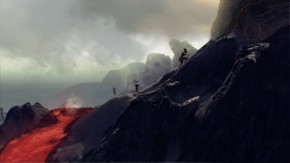 terrain, they suck up the little drop of water instead, which impedes their progress. This becomes a huge issue later in the game when circumstances require the player to quickly react in order to successfully move on to the next stage. Also, instead of being a disembodied god entity, the Breath is actually physically incorporated into the world. It is represented by a wispy trail of gold light that moves across the surface of the terrain. So when the player wishes to move across the map or select an object, they depend on this slowly moving material object to do so. It’s not too terribly game breaking but it can be disruptive at times.
terrain, they suck up the little drop of water instead, which impedes their progress. This becomes a huge issue later in the game when circumstances require the player to quickly react in order to successfully move on to the next stage. Also, instead of being a disembodied god entity, the Breath is actually physically incorporated into the world. It is represented by a wispy trail of gold light that moves across the surface of the terrain. So when the player wishes to move across the map or select an object, they depend on this slowly moving material object to do so. It’s not too terribly game breaking but it can be disruptive at times.
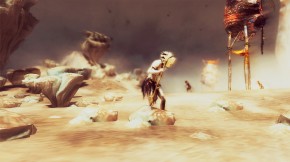 The game provides the player with unique abilities received from totems that tribesmen claim. These varied powers drastically affect the environment. One issue that arises from this comes from two specific abilities: infinite land and increased Breath. When combined, the game becomes not only easy but makes room for some nasty glitches. Namely, there was an instance where I decided to use infinite land with increased breath on a volcano. Since the abilities have short cool down times and sand turns to stone when in contact with lava, within two minutes I had an invincible, towering, distorted volcano that spewed lava in every direction so that I could no longer efficiently protect my island. Luckily, these circumstances are rare. The campaign provides very simple gameplay, but the true fun arises from the challenge mode. In this mode, the player is tasked with solving puzzling and unique situations. From strategically stopping water flows so tribesmen can slip by to their goal or diverting a lava flow into the ocean by utilizing precisely timed explosions (thank you Tommy Lee Jones), the game provides thought provoking situations that can be downright ingenious. There was one puzzle that literally had me shocked at the solution. That’s all I am going to say however for I do not wish to ruin it for you. What’s even better about the challenge mode is that, unlike the campaign’s thirteen short levels, it provides with thirty complex puzzles to solve. This is most definitely the cash crop of the game.
The game provides the player with unique abilities received from totems that tribesmen claim. These varied powers drastically affect the environment. One issue that arises from this comes from two specific abilities: infinite land and increased Breath. When combined, the game becomes not only easy but makes room for some nasty glitches. Namely, there was an instance where I decided to use infinite land with increased breath on a volcano. Since the abilities have short cool down times and sand turns to stone when in contact with lava, within two minutes I had an invincible, towering, distorted volcano that spewed lava in every direction so that I could no longer efficiently protect my island. Luckily, these circumstances are rare. The campaign provides very simple gameplay, but the true fun arises from the challenge mode. In this mode, the player is tasked with solving puzzling and unique situations. From strategically stopping water flows so tribesmen can slip by to their goal or diverting a lava flow into the ocean by utilizing precisely timed explosions (thank you Tommy Lee Jones), the game provides thought provoking situations that can be downright ingenious. There was one puzzle that literally had me shocked at the solution. That’s all I am going to say however for I do not wish to ruin it for you. What’s even better about the challenge mode is that, unlike the campaign’s thirteen short levels, it provides with thirty complex puzzles to solve. This is most definitely the cash crop of the game.
Visually, the game is beautiful. Most of the environments are very colorful and really give a nice consistency to this strange world. However, the unexpected use of a limited box area affects the full immersion into the world. For example, when tsunamis come, if the player goes to the edge of the map the tsunami is coming from, they will see a flat wall of water where against it. It seems to be an odd design choice when the developers could have easily designed a swell of water beyond these invisible walls. In another example, if some of the tribe is swept away in a flood but manage to wash up on dry land, occasionally models will freeze and never move for the rest of the game. Regardless, the style and setting gives off a vibrant and lush sensation that cannot dampened by such little bugs.
The sound design is fantastic as well. Though there isn’t much of a soundtrack, what little there is of one really holds significant power behind it. From the beginning of the game, the hatching of the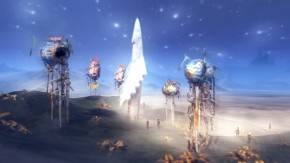 Breath is brought it with the pounding of drums and blasts from didgeridoos. It gives me goosebumps every time I hear it. Also, once tribes have access to wards against fire and water, they play heavy tribal sounds that really give the feeling of mystical strength repelling untamed forces. When explosions or tsunamis occur, they are accompanied with terrifying sound effects that sound as if the earth is being torn asunder. This is a very pleasing effect.
Breath is brought it with the pounding of drums and blasts from didgeridoos. It gives me goosebumps every time I hear it. Also, once tribes have access to wards against fire and water, they play heavy tribal sounds that really give the feeling of mystical strength repelling untamed forces. When explosions or tsunamis occur, they are accompanied with terrifying sound effects that sound as if the earth is being torn asunder. This is a very pleasing effect.
It is strange for a game like From Dust to have such mixed development qualities. On one hand, we have great visuals and sound but on the other we have poor gameplay mechanics that are essential for a gamer to truly enjoy it. Not only that, with the short campaign and only a decently lengthy challenge mode, From Dust does not provide much content. If a company is willing to take on the challenge of a god game, they definitely need to invest more energy into it. But considering the low cost and release to XBLA as well as PSN, it’s most likely that Ubisoft Montreal didn’t really plan for an epic but instead wanted to show off their interesting gameplay mechanics. Overall, From Dust is a decent game. It provides great features but doesn’t really hold longevity or polish enough to keep me hooked.



